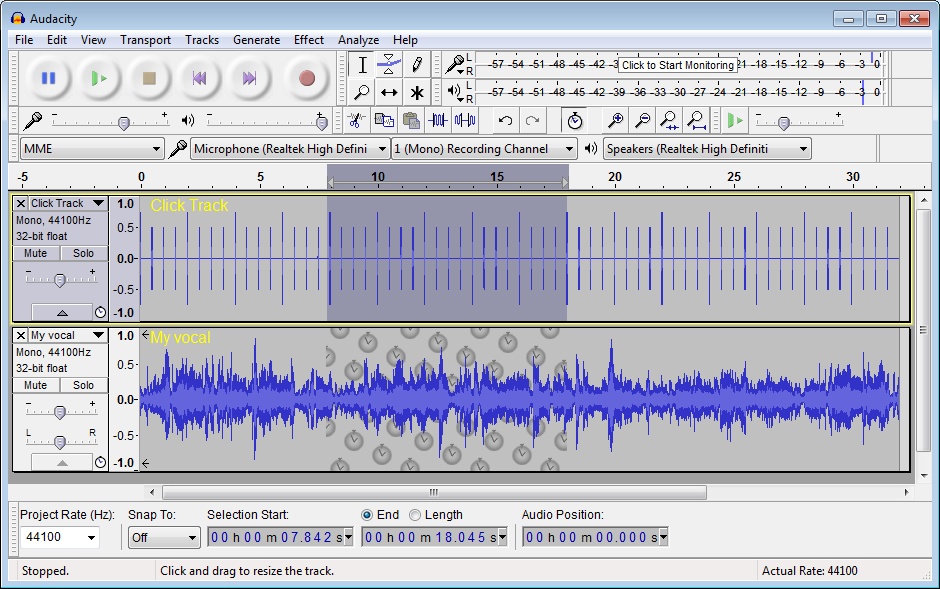Open M4a In Audacity
Audacity is a free, open source digital audio editor and recording application. Edit your sounds using cut, copy, and paste features (with unlimited undo functionality), mix tracks, or apply effects to your recordings. The program also has a built-in amplitude-envelope editor, a customizable spectrogram mode, and a frequency-analysis window for audio-analysis applications. Built-in effects include bass boost, wah wah, and noise removal, and the program also supports VST plug-in effects.
How to Merge MP3 Files in Audacity. Step 1 Open Audacity on Computer and Add MP3 Files. Having installed Audacity, double click to open it on your computer. Navigate to File Open to add the MP3 file you want to merge. Repeat the step to add another MP3 file, which will be shown in a new Audacity Window.
You can use Audacity to:
- Record live audio.
- Record computer playback on any Windows Vista or later machine.
- Convert tapes and records into digital recordings or CDs.
- Edit WAV, AIFF, FLAC, MP2, MP3 or Ogg Vorbis sound files.
- AC3, M4A/M4R (AAC), WMA and other formats supported using optional libraries.
- Cut, copy, splice or mix sounds together.
- Numerous effects including change the speed or pitch of a recording.
- Write your own plug-in effects with Nyquist.
- And more! See the complete list of features.
- Audacity is a free, open source digital audio editor and recording application. Edit your sounds using cut, copy, and paste features (with unlimited undo functionality), mix tracks, or apply effects.
- The problem you may be having opening M4a files in Audacity is that you probably don't have two required libraries installed in Audacity. For the M4a files you need the FFmpeg library And for Audacity to produce mp3 file it needs the Lame library They are simple to get and add.
- Feb 07, 2021 Convert WAV to MP3 With Audacity. Audacity is one of the best ways to edit audio files, so it's only natural to want to convert files with the program too. However, when you need to export an audio file in a format like WAV to MP3, you'll quickly learn that, by default, you can't do it—unless you tell Audacity where to find the LAME MP3 encoder.
Audacity 3.0 changelog:
- Now using aup3 unitary project file format.
- Over 160 bugs fixed.
See also: v3.0 Release Notes
Download page: Audacity 3.0 | 26.0 MB (Open Source)
View: Audacity Home Page
Get alerted to all of our Software updates on Twitter at @NeowinSoftware
2 file types use the .au file extension.- 1.Audacity Audio File
- 2.Audio File
File Type 1Audacity Audio File
| Developer | Audacity |
| Popularity | |
| Category | Audio Files |
| Format | Binary |
What is a AU file?
An AU file is an audio file created by Audacity, a free, cross-platform audio editor. It is saved in a proprietary audio format used only by Audacity. AU files are part of Audacity projects, which are saved as .AUP files.
When you create or import an audio file into an Audacity project, Audacity automatically converts the file into an AU file. Each project's AU files are stored in that project's folder, which is named myproject_data.
The myproject_data folder also contains your project's AUP file, which is named myproject.aup. When you open your AUP file in Audacity, Audacity automatically searches for and loads the AU files your project includes. If you've moved an AU file that was previously stored in the myproject_data folder, Audacity will show an error message when you open your AUP file.
After you've finished editing your Audacity project, you can export the audio the project contains as an .MP3, .WAV, .M4A, or other common audio file. This is the easiest way to convert the audio saved in an AU file into an audio file that can be played in other audio players.
NOTE: As of version 3.0, Audacity no longer saves AU files that users can access. Instead, Audacity saves all of a project's files within a single .AUP3 file, instead of within a myproject_data folder.
How do I open a AU file?
AU files are not meant to be opened individually. Instead, you should open the Audacity (cross-platform) project that uses your AU file. To do so, select File → Open... from Audacity's menu bar. Then, open the AUP file that is stored alongside your AU file, in your project's myproject_data folder.
Open over 400 file formats with File Viewer Plus.Programs that open AU files

Audacity M4a Support
File Type 2Audio File
| Developer | N/A |
| Popularity | |
| Category | Audio Files |
| Format | Binary |
.AU File Association 2
Audio file introduced by Sun Microsystems; used primarily on Sun or other Unix-based machines and has been adopted by several audio programs, including Adobe Audition and QuickTime; stores the data in three parts: a header (24 bytes), a variable length annotation block, and the actual audio data.
Programs that open AU files
How To Open M4a In Audacity
How To Open M4a In Audacity

Open M4a File In Audacity
